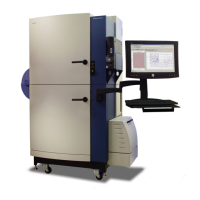FLIPR
®
Tetra High Throughput Cellular Screening System User Guide
0112-0109 H 183
Troubleshooting the FLIPR
Membrane Potential
Assay Kit
This section presents solutions to problems that users may encounter
when running membrane potential assays.
Fluorescence Drop Upon Compound Addition
This may result from dislodging cells from the wells during addition.
Shortening incubation times, plating cells on poly-D-lysine plates or
slowing the dispense speed should solve the problem in this case.
Adding volumes greater than recommended may increase the initial
fluorescence drop. In these cases it may be necessary to adjust the
volumes of the components. The recommended volume of the Loading
buffer is 100 μL for 96 well plate, 25 μL for 384 well plate or 2 μL for
1536-well plates.
CAUTION! Increasing the final in-well concentration of the Loading
Buffer may decrease the response of the assay. If only one addition is
required, then add the appropriate volume of buffer before addition
one.
Increase in Fluorescence
An increase of fluorescence may be observed upon buffer only
challenge. This increase is most likely due to a response of endogenous
ion channels to increasing ionic strength. Patch clamping data supports
this observed change. The choice of cells and expression levels of
endogenous channels can greatly influence resting and changing
membrane potentials. Match the compound addition buffer to the buffer
in the cell plate (culture medium plus dye loading buffer) so there is no
change in ion concentration upon compound addition.
No Response
Not all assays work well with all cell lines or channels. To address this
problem, we have developed two different assays to maximize the
opportunity for a successful assay. If you have not tried both FLIPR
®
Membrane Potential Assay Kit formulations, Blue and Red, then first try
the alternate kit to determine if your cell line is compatible. The FLIPR
®
Membrane Potential Evaluation Assay Kit (R8128) contains both
formulations in an Explorer Kit format to facilitate testing of cell lines,
channels, and compounds. If you do not see a change in fluorescence
with either formulation, then we suggest changing some of the assay
conditions.
Recommendations include: replacing media before dye loading, longer
incubation and assay times; preparing compounds in the loading
buffer; and choosing different buffers such as Tyrode’s or specific

